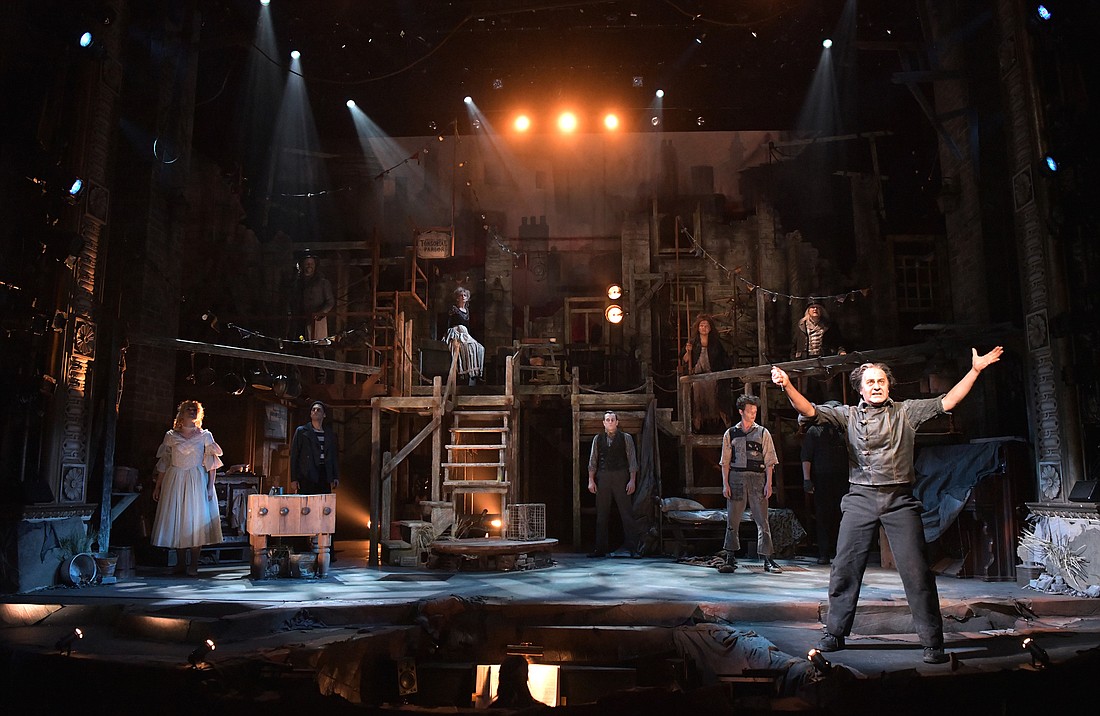- March 13, 2025
-
-
Loading

If you’re hungry for razor-sharp satire, check out Asolo Repertory Theatre’s incarnation of “Sweeney Todd: The Demon Barber of Fleet Street.” It’s a new take on Stephen Sondheim’s classic recipe for dark musical comedy.
To give due credit, Sondheim wrote the music and lyrics; Hugh Wheeler penned the script, based on Christopher Bond’s 1973 theatrical adaptation of a lurid Victorian melodrama. The story is fiction. But it’s gripping.
Once upon a time during the reign of Queen Victoria, a young barber lived happily with his wife, Lucy, on Fleet Street in London. The corrupt Judge Turpin (James Ramlet) lusted for Lucy. He framed the innocent barber for a crime, shipped him to Australia, and abducted his wife for immoral purposes. 15 years later, the barber escaped from the penal colony. He changed his name to “Sweeney Todd,” returned to Fleet Street, and met Mrs. Lovett, the proprietor of a struggling meat pie emporium. She informed him that Lucy had gone mad and taken arsenic. This news made Sweeney quite mad. In both senses of the word. He decided to kill the judge and his homicidal toady (Colin Anderson). When he failed, Sweeney decided to kill everyone.
He opened up a barbershop above Mrs. Lovett’s shop and got to work. A few select clients (who wouldn’t be missed) got a very close shave. The enterprising Mrs. Lovett then chopped up their bodies, and baked them into pies. Her meat shop becomes a hit, but she still wasn’t happy. She loved Sweeney; he only loved revenge. And … Well, the story just gets worse from there. There’s no happy ending. Sorry.
Director Peter Rothstein dials the Grand-Guignol spectacle up to 11. Good taste would ruin this cannibal comedy. He avoids it all costs with a gutsy comic strategy. He takes the narrative dead seriously, and the actors play it straight. Only ten, but they’re all outstanding performers. With operatic voices to boot.
Allen Fitzpatrick shines like a new razor blade in the lead role. With a thousand-yard stare and a clenched lantern jaw worthy of John Lithgow, he definitely looks the part. His Sweeney is a Victorian victim of post-traumatic stress disorder. He’s a tortured man who’s sacrificed his soul on the altar of revenge. Sally Wingert is wickedly comic as the wicked Mrs. Lovett. She’s maternal, loving, opportunistic and ruthless. (What a woman!) Evan Tyler Wilson is also hoot as a rival barber who learns the true meaning of cutthroat competition.
Ramlet’s Judge Turpin could’ve walked out of a John Tenniel illustration. He’s an odious, rolling tower of ruling class entitlement. Anderson delivers an equally vile characterization as the evil judge’s deadly flunky. Sara Ochs is gripping as a piteous mad woman who roams the streets begging for alms. Her character’s constantly popping up at the worst possible moment like some vengeful spirit. David Darrow’s crowd-pleasing Toby is a high-spirited, naïve orphan who’d find a happy life in a Charles Dickens novel. He doesn’t in Sondheim’s musical. Perry Sherman and Elizabeth Hawkinson are sweetly sympathetic as a loving young couple. They somehow beat the odds and make it out of Fleet Street alive.
The Asolo Rep’s stripped-down show has the intimacy of the Black Hole of Calcutta. It’s not a sprawling narrative. It’s a bottle story of gods, demons and monsters. Ten actors playing multiple parts, all packed together in a claustrophobic set. And what a set it is.
Alice Louise Frederickson’s costumes are mainly cast-offs — a perfect fit for disposable people. Sweeney somehow got his hands on a full-body leather tunic. It seems expensive, but let’s not ask where he got it. London’s preening elite are another sartorial exception. Their pricey garb looks even worse.
Kate Sutton-Johnson’s dead-end street is a slice of steampunk hell. A rat’s maze of rotting wood and rickety stairs, all strung with lights, and riddled with trap doors and convenient slides for easy corpse disposal. Welcome to late Victorian London, where life was nasty, poor brutish and short. It’s so ugly it’s beautiful.
Paul Whitaker’s lighting is expressionistic and inventive. Darkness rules, with occasional flashes of fever-dream light. One quibble: A flashing orange spotlight is a substitute for gore in this surprisingly bloodless production. Clever. But why not bloody red?
Musical director Gregg Coffin hits it out of the park. The orchestra in the appropriately named “pit” stays on track through all the switchback turns of Sondheim’s brilliant, difficult score. Timing is everything — and the unseen instrumentalists stay in synch with the vocalists on stage. Impressive work. But that’s true for everyone involved in this show
It’s a bloody entertaining musical. With something for everybody.
“Sweeney Todd” is a savage smorgasbord of social commentary, class struggle, music, poetry and the lighter side of cannibalism. It’s the saga of Sweeney’s rip-roaring revenge. It’s a parody of Victorian melodramas — nasty little shockers, disguised as moral lessons. It’s also more than parody. Yes, it mocks the hypocrisy of those cheaply printed “penny dreadfuls.” But the narrative grips you all the same.
The musical’s bloody story is over-the-top. But it also reflects dark realities. The powerful feed on the powerless. Hurt people hurt people. Injustice breeds monsters. Sweeney Todd was one of them.
He won’t be the last.